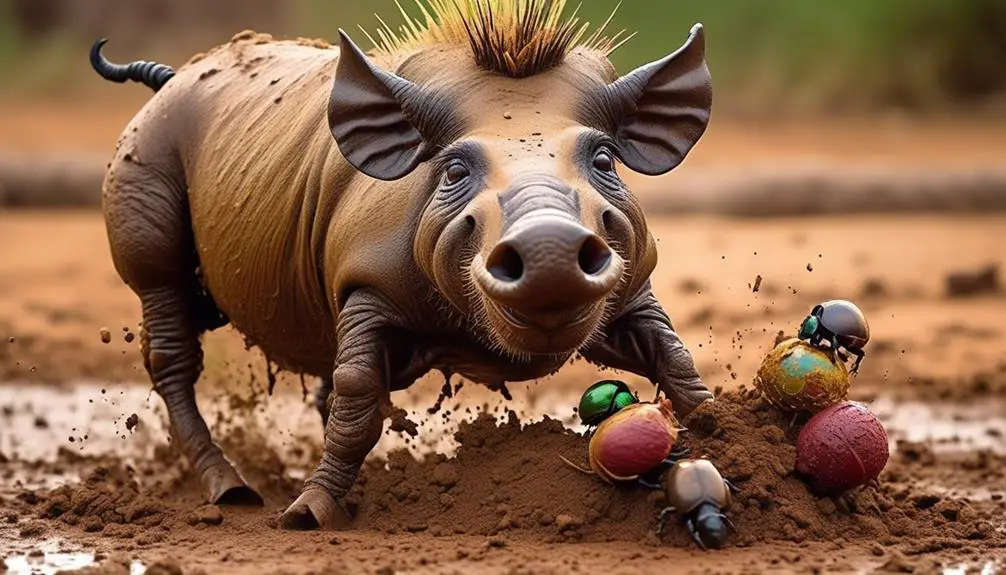Are you ready to step into the grimy world of the dirtiest animals? Prepare to be astounded and slightly repulsed as we uncover the creatures that thrive in filth and disease. From bats carrying deadly pathogens to seagulls spreading hard-to-cure infections, these animals will leave you both amazed and appalled.
But it’s not just about the grime and germs; we’ll also explore their remarkable adaptations, unique behaviors, and the intricate balance they maintain in their ecosystems.
However, the conversation doesn’t stop there. We’ll also delve into the ethical considerations and our complex relationship with these creatures.
So, get ready to embark on a journey that will challenge your perception of cleanliness and leave you questioning our place in the natural world.
Bats and Disease-Carrying Potential

Bats possess the potential to carry and transmit diseases, making them significant vectors of pathogens and parasites, including deadly viruses such as Ebola and rabies. Bats are known reservoirs for a variety of viruses, including the Marburg virus and the Nipah virus. These viruses can cause severe illnesses in humans and have high mortality rates. The transmission of these viruses occurs through direct contact with bat saliva, urine, or feces, as well as through the consumption of bat meat.
One reason bats are efficient disease carriers is their ability to host a large number of viruses without getting sick themselves. This is due to their unique immune system, which allows them to tolerate viral infections. Additionally, bats have a unique physiology that enables them to fly long distances and migrate, which contributes to the spread of diseases across different regions.
Bats also play a crucial role in the maintenance and transmission of parasites. Their guano, or feces, can harbor various pathogens, including the fungus that causes histoplasmosis. Histoplasmosis is a respiratory disease that can be contracted by inhaling fungal spores present in bat droppings.
It is important to note that not all bats carry diseases, and the majority of interactions between bats and humans occur without any negative health consequences. However, it’s crucial to exercise caution when handling bats or coming into contact with their droppings, as these actions can result in serious illnesses.
Vultures and Carrion Consumption

Vultures play a crucial role in disease prevention through their carrion consumption. By feeding on dead animals, vultures help prevent the spread of diseases that can arise from decomposing carcasses.
Their efficient digestive systems allow them to safely consume carrion that would otherwise become breeding grounds for harmful pathogens.
Disease Prevention Through Scavenging
Scavenging plays a crucial role in preventing the spread of diseases by efficiently disposing of carrion in the animal kingdom. Vultures, in particular, are carrion-eating birds that play a significant role in disease prevention.
They have highly acidic stomachs that can destroy many harmful pathogens, including bacteria like E. coli and Salmonella. By consuming carcasses, vultures remove potential breeding grounds for disease-causing organisms, preventing the spread of infections.
Moreover, vultures have a strong immune system that allows them to tolerate and eliminate various pathogens. Without vultures, dead animals would pile up, leading to the proliferation of diseases.
Therefore, their scavenging behavior serves as a natural defense mechanism against the spread of pathogens in the environment.
Ecological Role of Vultures
With their ability to efficiently dispose of carrion and prevent the spread of diseases, vultures play a crucial ecological role in maintaining the balance of ecosystems.
As scavengers, vultures feed on dead animals, known as carrion, which would otherwise accumulate and pose a risk of disease transmission. Vultures have several adaptations that allow them to consume carrion without getting sick.
Their highly acidic stomachs can neutralize and kill harmful bacteria, viruses, and parasites present in the carrion. Additionally, their bald heads and specialized digestive systems prevent the accumulation of bacteria on their feathers and ensure efficient digestion.
Striped Polecats and Foul-Smelling Spray
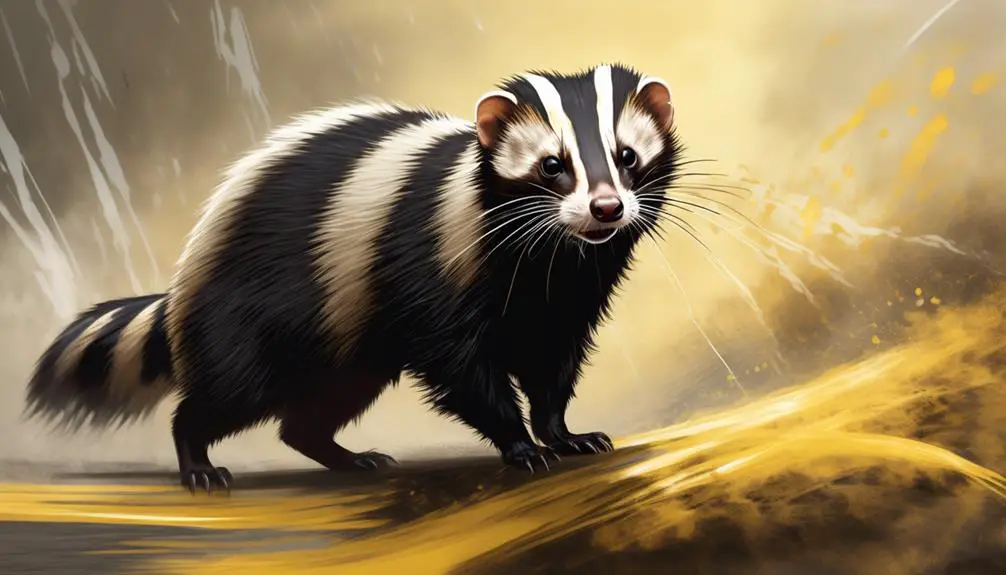
Striped polecats, also known as African skunks, possess a unique defense mechanism in the form of a foul-smelling spray. When threatened, these small carnivores have the ability to release a pungent secretion from their anal glands. The spray is composed of a mixture of chemicals, including sulfur-containing compounds, which give it its offensive odor. This noxious liquid can be projected accurately in the direction of the predator, effectively deterring potential attackers. The smell is so strong that it can linger in the surrounding environment for a considerable period of time.
The foul-smelling spray serves as a warning to predators, signaling that the striped polecat isn’t an easy target. It acts as a form of chemical defense, allowing these animals to protect themselves without resorting to physical confrontation. The odor is often described as being similar to that of rotten eggs or skunk spray. This powerful scent is an effective deterrent, ensuring that predators think twice before attempting to prey upon the striped polecat.
The ability of striped polecats to produce such a foul-smelling spray is an adaptation that has likely evolved as a survival strategy. By using this chemical defense, they can avoid predation and increase their chances of survival in their natural habitat. This unique defense mechanism showcases the remarkable adaptations that animals possess to thrive in their environments.
Koalas and Chlamydia Infection
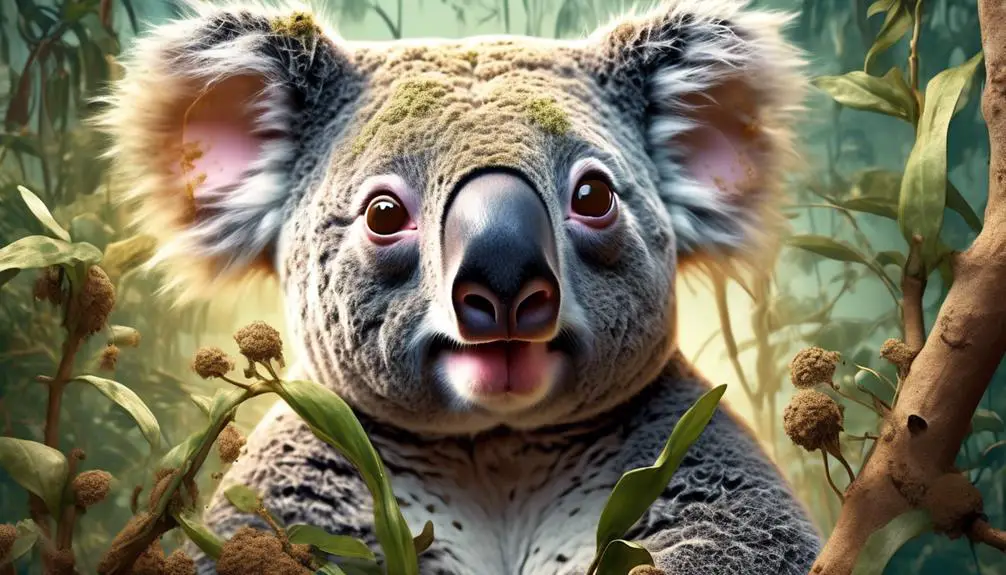
Koalas, a beloved symbol of Australia, are unfortunately afflicted by chlamydia infections. This bacterial infection can cause severe side effects and even death in koalas.
Understanding the risks and implementing measures to prevent and treat chlamydia in koalas is crucial for their health and conservation.
Chlamydia in Koalas
Chlamydia infection is a prevalent and concerning issue in the koala population. Chlamydia, caused by the bacterium Chlamydia pecorum, affects a significant percentage of koalas, leading to severe side effects and even death. The infection primarily affects the reproductive system, causing infertility, urinary tract infections, and inflammation of the bladder.
Koalas can contract chlamydia through direct contact with infected individuals or through contaminated environments. The bacterium can be transmitted from mother to joey during birth or through grooming behaviors.
Due to the high prevalence of chlamydia in koalas, efforts are being made to develop effective vaccines and improve diagnostic methods for early detection and treatment. Understanding the factors contributing to the spread of this infection is crucial for the conservation of koalas and their habitats.
Koala Health Risks
The health risks associated with koalas and their susceptibility to chlamydia infection are a significant concern in conservation efforts. Chlamydia is a bacterial infection that affects a percentage of koalas, causing severe side effects and even death. It is crucial to understand the health risks posed by chlamydia in order to develop effective strategies for the conservation and management of koala populations. To provide a clearer picture of the health risks, here is a table outlining the main health effects of chlamydia infection in koalas:
| Health Risks of Chlamydia Infection in Koalas |
|---|
| – Conjunctivitis |
| – Urinary tract infections |
| – Infertility |
| – Inflammation of reproductive organs |
Preventing Koala Infections
To effectively protect koalas from the risks of chlamydia infection, it’s essential to implement preventive measures that target the transmission and spread of the bacterial disease.
Chlamydia is a significant health issue for koalas, causing severe side effects and even death. One of the primary ways to prevent the spread of chlamydia is through managing and controlling the koala population. This includes implementing population control measures, such as contraception and sterilization programs, to reduce the density of koalas in affected areas.
Additionally, regular health screenings and testing of koalas for chlamydia can help identify infected individuals and isolate them for treatment. Promoting habitat preservation and reducing stressors, such as habitat loss and fragmentation, can also aid in preventing the spread of chlamydia among koalas.
Seagulls: ‘Rats of the Sky

Seagulls, often referred to as the ‘rats of the sky,’ are known for their scavenging behavior and ability to thrive in urban environments. These birds are opportunistic feeders, taking advantage of food sources in both coastal and inland areas. Seagulls have adapted well to human activities, making them a common sight in cities, harbors, and beaches around the world.
One of the main reasons seagulls are considered dirty animals is their feces. Seagull droppings contain a bacterium called Enterococcus, which can cause difficult-to-cure infections in humans. When seagulls defecate on buildings, sidewalks, or public spaces, the bacteria can contaminate surfaces and pose a health risk.
Furthermore, seagulls are notorious for their aggressive behavior when it comes to food. They’re known to snatch food directly from people’s hands or steal it from unattended plates. This behavior can be a nuisance and even pose a safety hazard, especially in crowded areas where seagulls gather in large numbers.
While seagulls play an important role in the ecosystem by helping to control pest populations and recycling organic waste, their scavenging habits and proximity to human settlements contribute to their reputation as dirty animals. It’s important to take precautions when encountering seagulls to minimize the risk of infection and maintain cleanliness in urban environments.
Giraffes and Nose Cleaning Behavior
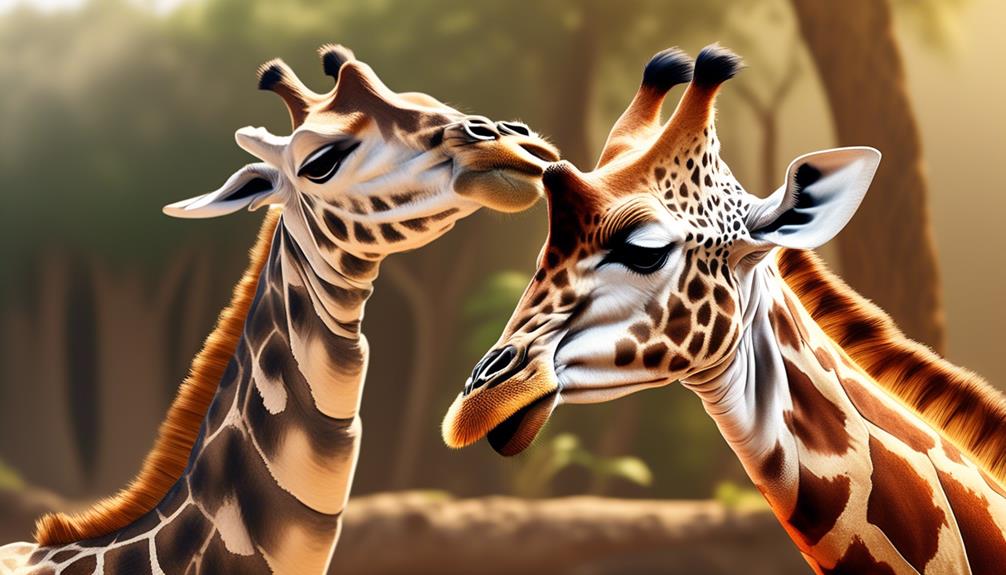
Giraffes exhibit a unique behavior of using their long tongues to clean their noses and ears. This behavior is not only fascinating but also serves a practical purpose in maintaining their hygiene. The long tongues of giraffes allow them to reach deep into their nostrils and ears, removing any dirt, debris, or irritants that may have accumulated. By cleaning their noses and ears, giraffes prevent the build-up of bacteria or parasites that could potentially cause infections or discomfort.
To give you a better understanding of this behavior, let’s take a closer look at the process. Giraffes use their tongues, which can be up to 18 inches long, to reach inside their nostrils and ears. They then lick and wipe the surfaces, effectively removing any unwanted substances. This behavior is not only efficient but also showcases the adaptability and versatility of the giraffe’s long tongue.
In order to evoke emotion and engage the audience, let’s take a moment to compare the giraffe’s nose cleaning behavior to our own personal hygiene routines. The table below highlights the similarities and differences between giraffes and humans in terms of nose cleaning behavior.
| Giraffes | Humans |
|---|---|
| Use long tongues to clean noses and ears | Use tissues or cotton swabs to clean noses and ears |
| Reach deep into nostrils and ears | Clean the external surfaces only |
| Prevent build-up of bacteria or parasites | Prevent build-up of dirt and mucus |
As we can see, while giraffes have their unique way of cleaning their noses and ears, humans rely on different tools and methods to achieve the same result. Nonetheless, the importance of maintaining good hygiene remains universal across species.
Hippos and Territory Marking
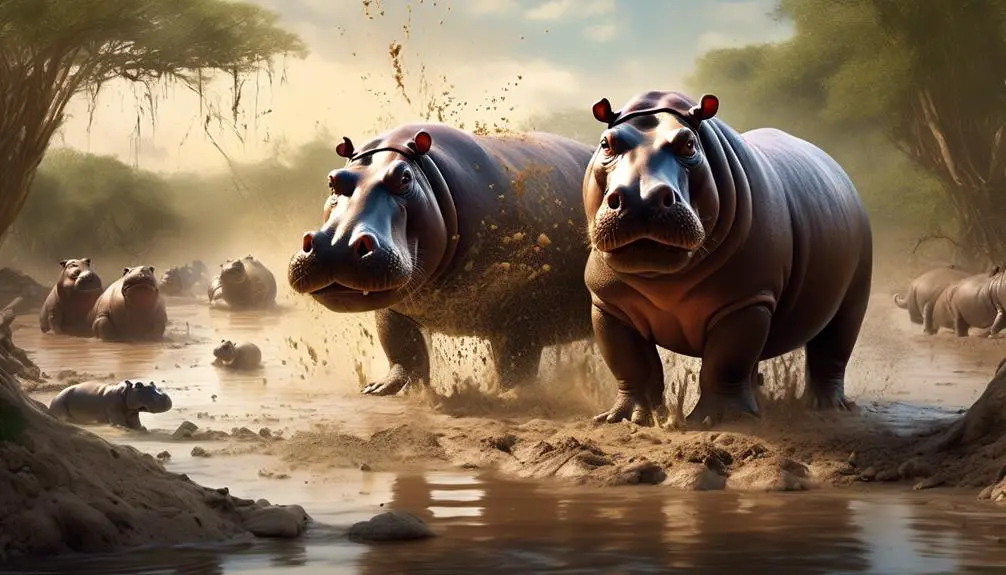
Hippos mark their territory by urinating and defecating, using their tails to fling gunk around. This territorial behavior is an important aspect of hippo social dynamics. By marking their territory, hippos communicate their presence and assert dominance over a particular area. The act of urinating and defecating is accompanied by the flicking of their tails, which helps spread their scent and feces over a wider area.
Hippos have specialized glands near their anus that release a pungent secretion, enhancing the effectiveness of their territorial marking. This secretion contains chemical compounds that convey important information to other hippos in the vicinity. It serves as a means of communication, allowing individuals to recognize and respect the established boundaries.
Territory marking in hippos isn’t only a way to assert dominance and communicate, but it also plays a role in mating rituals. Male hippos mark their territories to attract females and deter rival males. The strong odor and visual evidence left behind by territorial marking serve as a clear indication of a male’s presence and status.
Understanding the territorial behavior of hippos provides valuable insights into their social structure and reproductive strategies. It highlights the complex and intricate nature of their communication systems, which are essential for maintaining social order within hippo communities.
Hedgehogs and Pooping Propensity
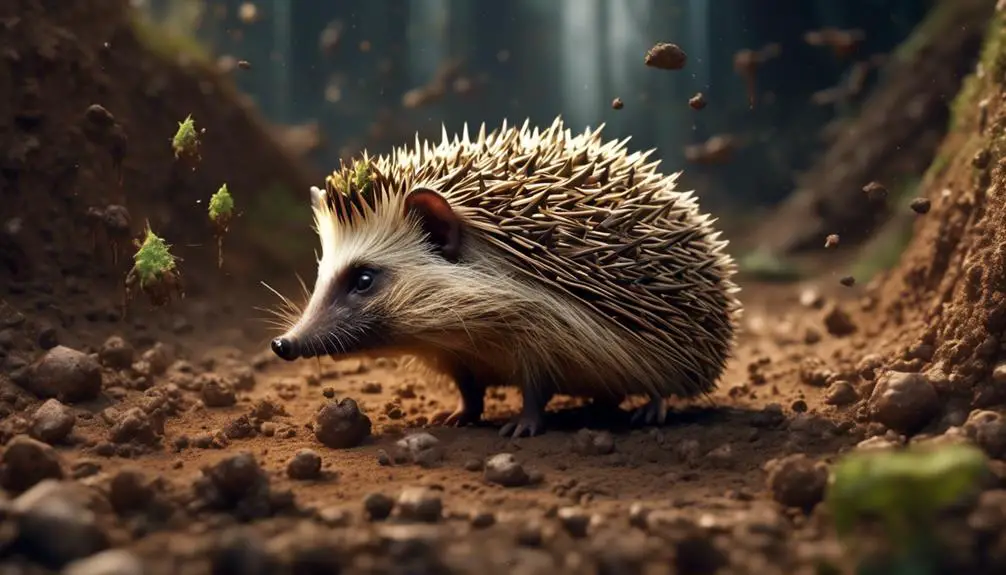
Hedgehogs demonstrate a natural propensity for defecating as part of their regular behavior. This behavior is an essential aspect of their physiology and plays a crucial role in their overall health and survival. To better understand the pooping propensity of hedgehogs, let’s take a closer look at their defecation habits.
| Defecation Habits of Hedgehogs | |
|---|---|
| 1 | Hedgehogs have a regular schedule for defecation, typically occurring once or twice a day. |
| 2 | They prefer to defecate in secluded areas, such as under bushes or in tall grass, to maintain their safety and avoid attracting predators. |
| 3 | Hedgehog feces are small, cylindrical pellets with a dark brown color. These pellets are composed of undigested food, hair, and other waste materials. |
Understanding the pooping propensity of hedgehogs allows us to appreciate the importance of this behavior in their daily routine. This natural inclination for defecation ensures that hedgehogs maintain a healthy digestive system and properly eliminate waste from their bodies. By adhering to their regular defecation schedule and finding suitable locations for this activity, hedgehogs can help maintain cleanliness in their environment and minimize the risk of attracting unwanted attention from predators.
Flies and Vomit Consumption Habits
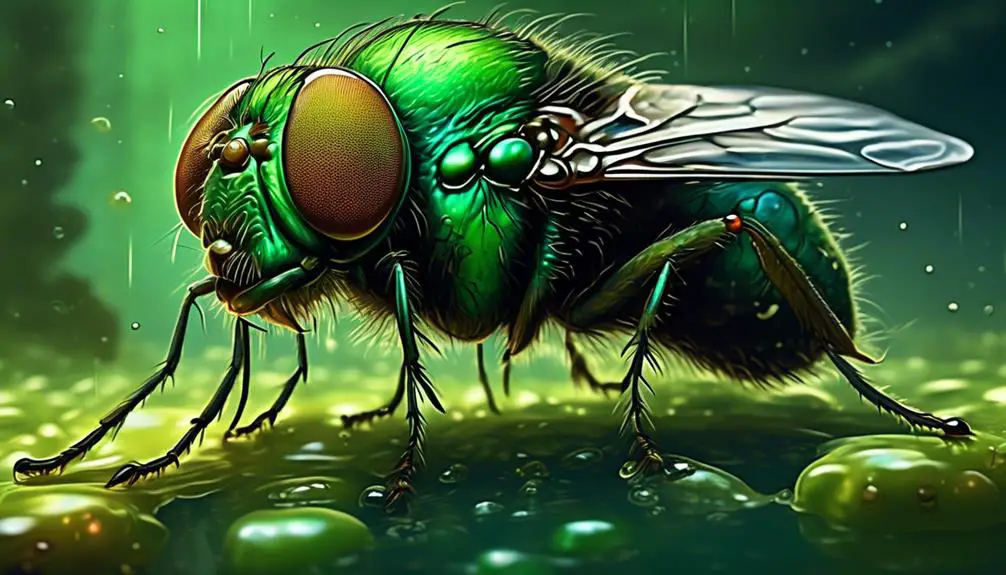
Flies, known for their unsavory habits, have a peculiar consumption behavior that involves vomiting their digestive juices onto food before ingesting it. This behavior, called regurgitation, is a part of their feeding process. When flies land on food, they first taste it by regurgitating their digestive fluids onto the surface. These fluids contain enzymes that break down the food and make it easier for the flies to consume. Once the food is partially liquefied, the flies use their sponge-like mouthparts to suck up the liquid. This process allows flies to extract nutrients from a wide range of food sources, including decaying matter, animal feces, and even human food.
While this behavior may seem repulsive to humans, it serves an important purpose for flies. By regurgitating their digestive juices onto food, flies are able to pre-digest it and ensure that it’s in a suitable state for consumption. Additionally, their vomit contains antimicrobial properties that help kill bacteria and other pathogens that may be present on the food. This adaptation allows flies to thrive in environments that would be inhospitable to many other organisms.
However, it’s important to note that flies can also transmit diseases through this feeding behavior. When flies land on feces or other sources of pathogens, they can pick up bacteria and viruses on their bodies. These pathogens can then be transferred to the food they regurgitate on, potentially contaminating it and causing illness if consumed by humans. Therefore, it’s crucial to maintain proper hygiene and food safety practices to minimize the risk of disease transmission from flies.

Erzsebet Frey (Eli Frey) is an ecologist and online entrepreneur with a Master of Science in Ecology from the University of Belgrade. Originally from Serbia, she has lived in Sri Lanka since 2017. Eli has worked internationally in countries like Oman, Brazil, Germany, and Sri Lanka. In 2018, she expanded into SEO and blogging, completing courses from UC Davis and Edinburgh. Eli has founded multiple websites focused on biology, ecology, environmental science, sustainable and simple living, and outdoor activities. She enjoys creating nature and simple living videos on YouTube and participates in speleology, diving, and hiking.
🌿 Explore the Wild Side!
Discover eBooks, guides, templates and stylish wildlife-themed T-shirts, notebooks, scrunchies, bandanas, and tote bags. Perfect for nature lovers and wildlife enthusiasts!
Visit My Shop →
